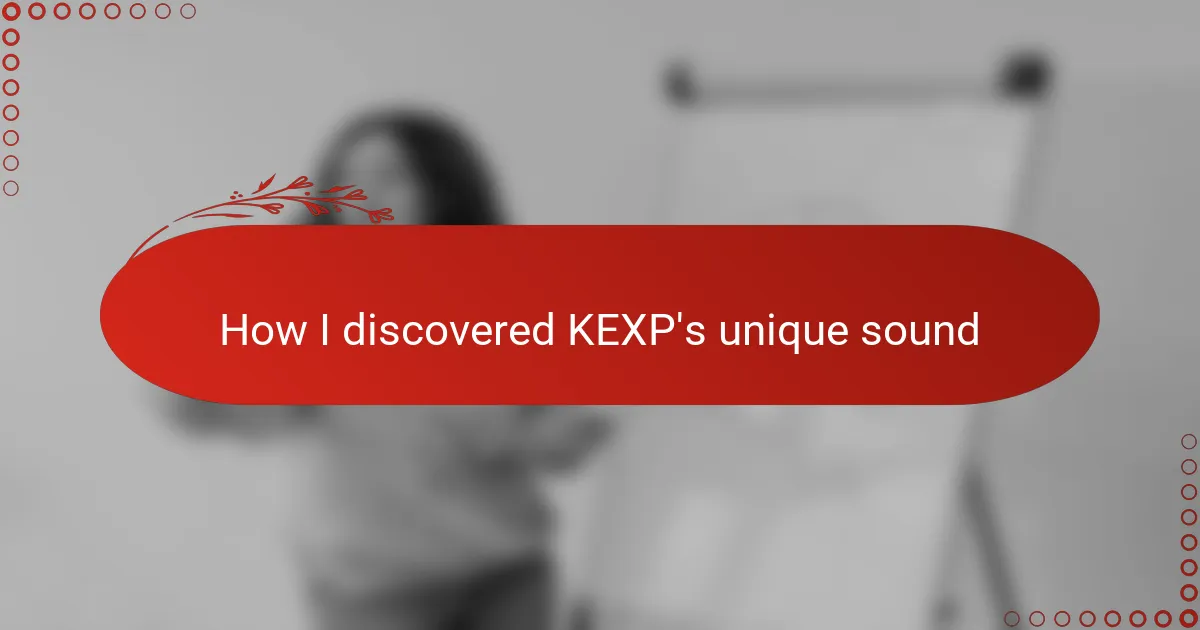Key takeaways
- Radio broadcasting creates a unique atmosphere that fosters personal connections and shared experiences among listeners.
- KEXP stands out for its eclectic blend of genres, authentic storytelling, and commitment to underrepresented artists, transforming it into a platform for cultural exploration.
- Distinctive sound elements, such as ambient noise and the DJ’s voice modulation, contribute to a memorable listening experience that captivates audiences.
- To develop a unique radio sound, embrace authenticity, experiment with pacing, and incorporate unexpected audio elements to enhance the broadcast’s texture.
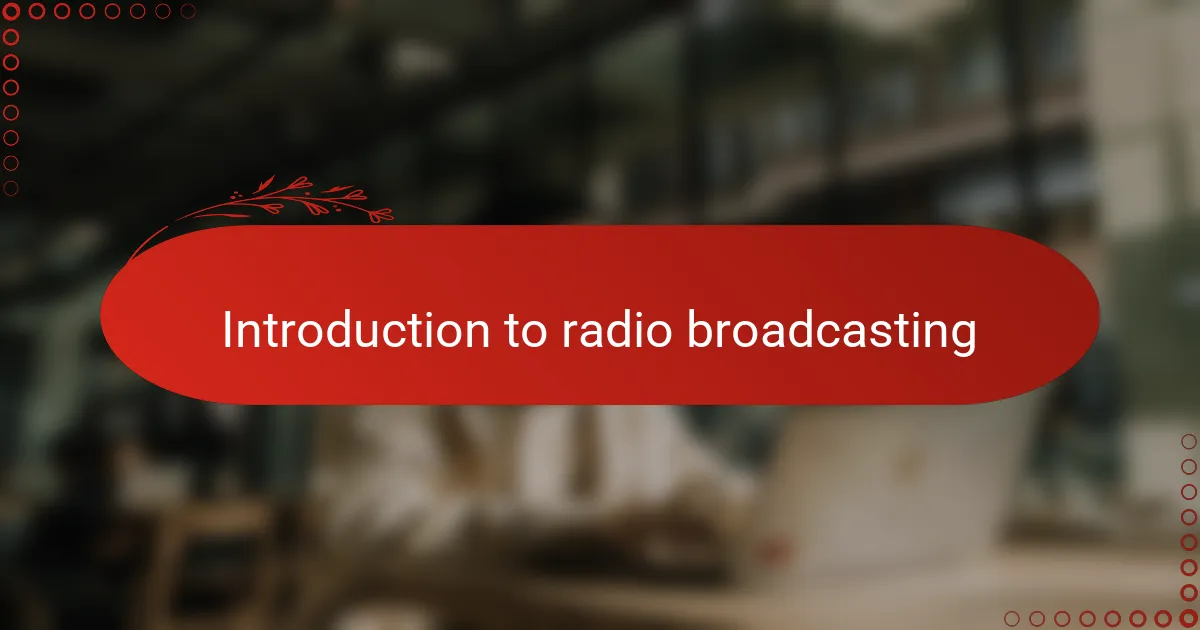
Introduction to Radio Broadcasting
Radio broadcasting has always fascinated me because it blends technology with storytelling in a way few other mediums can. There’s something almost magical about tuning in and being instantly connected to voices and music from miles away. Have you ever wondered how a simple radio signal can create such a powerful sense of community and shared experience?
From my experience, radio isn’t just about sound; it’s about the unique atmosphere it creates. It’s that intimate feeling of having someone speak directly to you, even though hundreds or thousands of others are listening too. This personal connection is what makes radio broadcasting so enduring and special.
I’ve often thought about the skill it takes to craft a radio show—balancing content, pacing, and sound quality to keep listeners engaged. Behind every great broadcast is a mix of creativity and technical know-how that transforms ordinary sounds into something unforgettable. Isn’t that what makes radio such a compelling art form?
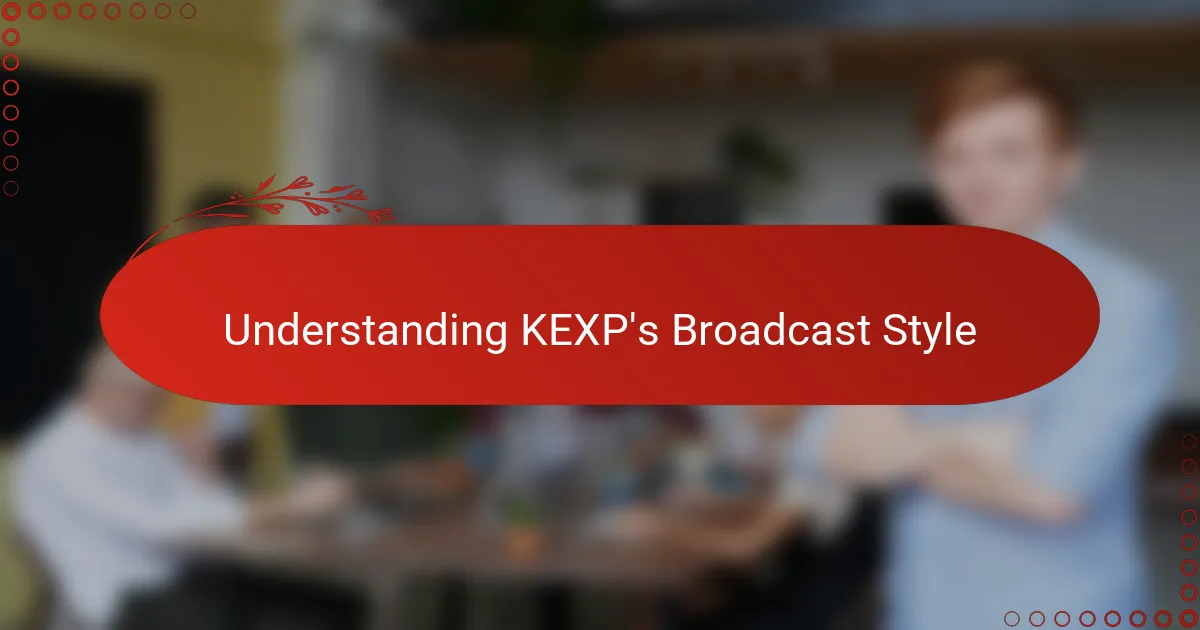
Understanding KEXP’s Broadcast Style
What struck me instantly about KEXP’s broadcast style was its fearless blend of genres and voices, creating an eclectic soundscape that feels both curated and spontaneous. It’s like tuning into a friend who knows exactly what you didn’t realize you needed to hear next. Have you ever experienced a radio show that surprises you in the best possible way every few minutes? That’s exactly how KEXP kept me hooked.
I noticed how the DJs don’t just play tracks—they tell stories, share insights, and create a sense of discovery. Their passion seeps through the mic and resonates with listeners, making each broadcast feel like a personal invitation into a vibrant music community. From my perspective, this approach transforms radio from passive background noise into an active, emotional experience.
What really sets KEXP apart, in my opinion, is their commitment to authenticity and diversity. They don’t chase mainstream trends but instead highlight emerging artists and underrepresented sounds. This fearless dedication made me realize that radio can be a platform for cultural exploration, not just entertainment. Wouldn’t you agree that a broadcast style like this changes the way we connect with music altogether?
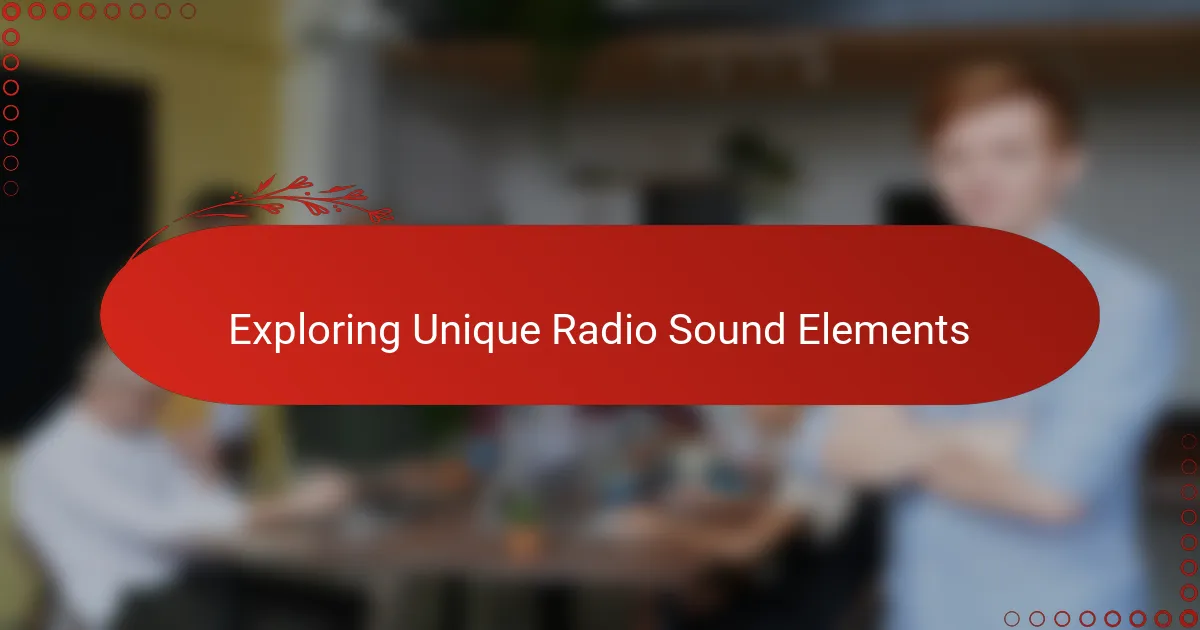
Exploring Unique Radio Sound Elements
When I first started paying attention to the layers that make up a radio station’s sound, I realized it’s not just about what you hear but how those sounds are woven together. Elements like ambient room noise, DJ voice tone, and even the timing between songs can create a feeling that’s unique to each station. Have you ever noticed how some stations feel warm and inviting while others come off as cold or mechanical? That subtle atmosphere shapes so much of the listening experience.
One thing that really caught my ear with KEXP was how they use space in their broadcasts—the way conversations flow naturally, without feeling scripted or rushed. It’s like being invited into someone’s living room for a chat rather than just overhearing a playlist. From my perspective, this kind of organic soundscape adds an authenticity that makes the music and stories far more memorable.
I also appreciate how KEXP blends unexpected sound elements, like live performances or occasional street noise, which gives the broadcast texture and life. It’s these small, often overlooked details that transform a routine radio hour into something alive and unpredictable. Doesn’t that make you wonder how much care goes into crafting such an immersive audio environment?

Techniques to Identify Distinct Broadcasts
One technique I rely on to identify distinct broadcasts is tuning into the station’s use of voice modulation and speech patterns. When a DJ’s tone shifts naturally—calm one moment, energized the next—it creates a dynamic flow that immediately signals a unique broadcast style. Have you ever caught yourself recognizing a station just by the way a host’s voice carries emotion or personality?
Another method I find revealing is paying attention to the editing rhythm between songs and segments. Some stations have precise, rapid transitions, while others prefer lingering silences or organic overlaps. I once compared two shows back-to-back and realized how these timing choices instantly colored the overall mood, almost like a station’s signature tempo.
Lastly, immersive sound layering stands out as a powerful clue to distinct broadcasting. Elements like background ambiance, occasional audience reactions, or even crackles from vinyl add depth that differs vastly between broadcasts. From my experience, these subtle textures are what transform an ordinary radio hour into something truly memorable and unmistakably unique. Have you noticed how these details pull you deeper into the experience?
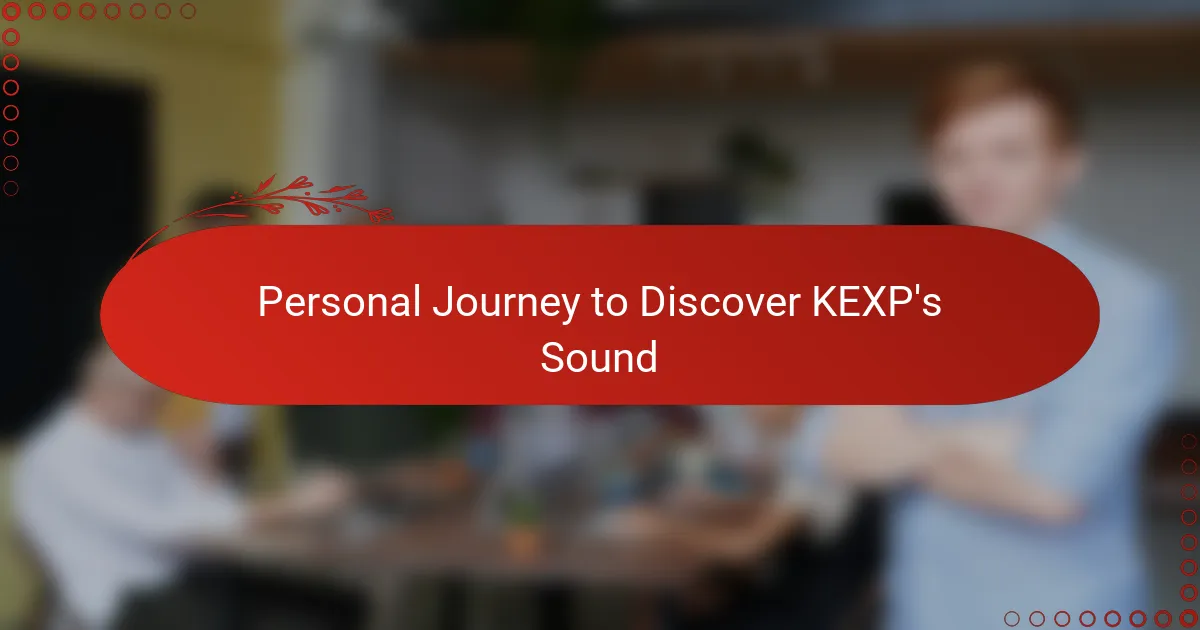
Personal Journey to Discover KEXP’s Sound
I remember the first time I stumbled upon KEXP while scanning through stations on a lazy afternoon. Something about their sound felt refreshingly different—like I’d found a secret doorway into a world where music breathed and stories unfolded naturally. Did you ever tune in somewhere and instantly feel like you belonged? That’s exactly what happened to me with KEXP.
What really captivated me was how KEXP’s broadcast seemed alive, almost like the DJs were right there in the room with me. Their voices didn’t just announce songs; they shared personal moments and invited me into a deeper connection with the music. It was this genuine, unpolished vibe that made me lean in closer, eager to hear what would come next.
Looking back, I realize that discovering KEXP’s sound was less about the songs themselves and more about the layered atmosphere they created—an inviting mix of warmth, spontaneity, and authenticity. Have you ever felt a broadcast so alive that it changed how you experience radio forever? For me, KEXP’s unique sound did exactly that.
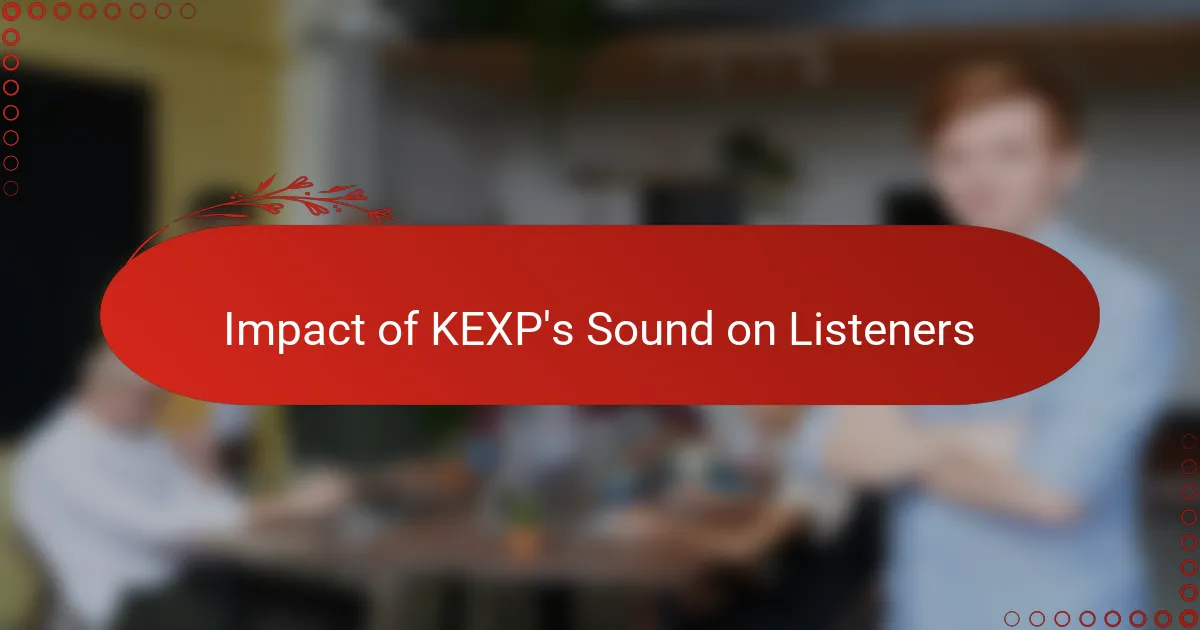
Impact of KEXP’s Sound on Listeners
The impact of KEXP’s sound on listeners is something I found both subtle and profound. I remember moments when a track would play, and the seamless blend of voices and music wrapped around me like a comforting embrace. Have you ever felt that a radio station wasn’t just playing songs, but actually understanding what you needed to hear that day?
What struck me most was how KEXP’s unique atmosphere encouraged me to explore music with fresh ears. It wasn’t just background noise—it invited curiosity and connection. From my experience, this kind of listening transforms casual fans into passionate advocates, turning a routine radio moment into something deeply personal.
I also noticed how KEXP’s authentic vibe often sparked a real emotional response. Sometimes it was joy, sometimes nostalgia, and other times a quiet sense of hope. Don’t you think that when a station can make listeners feel so much, it’s more than just sound? It becomes a shared experience that lingers long after the broadcast ends.

Tips to Find Your Unique Radio Sound
Finding your unique radio sound begins with embracing what feels authentic to you rather than chasing popular trends. I learned early on that when I let my own voice and musical tastes shine through honestly, listeners respond to that raw sincerity. Have you ever noticed how the stations you connect with most don’t try to be someone else but simply own their style?
Another tip I swear by is experimenting with the pacing and transitions in your broadcasts. It took me a few tries to discover that the way I space conversations and music—sometimes lingering on silence, other times cutting sharply—can make all the difference in creating a mood that’s distinctly mine. What subtle shifts have you tried that helped your show stand out?
Lastly, layering your sound with unexpected elements can be a game-changer. I found that incorporating ambient noises or spontaneous moments brings a texture that keeps the listening experience fresh and alive. It’s those little details that turn broadcasting from routine to memorable, don’t you think?
